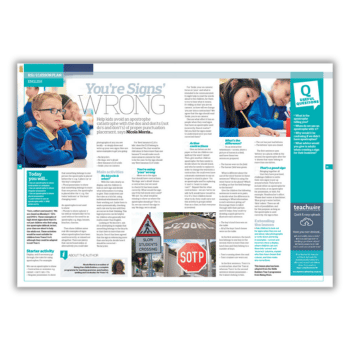Use this apostrophe KS2 lesson plan that focuses on the dos and don’ts of proper punctuation placement to help pupils avoid an apostrophe catastrophe.
- Tea’s, coffee’s and snack’s
- We are closed on Monday’s
- CD’s and DVD’s
These examples of high street signs show that it’s not just children who find using the apostrophe difficult. In fact, your class are about to help the adults out.
These activities are most suitable for children from Years 3 to 6, although you can adapt them to suit Year 2.
Apostrophe KS2 learning objectives
- Use an apostrophe to show contraction or omission
- Use an apostrophe to show singular possession
- Use an apostrophe to show plural possession
- Learn when to use an apostrophe with ‘s’ and when not to
Starter activity
Display, and if necessary go through, the rules for using apostrophes. For example: We use an apostrophe to show:
- Contraction or omission: e.g. cannot = can’t; I am = I’m.
- Singular possession: to show that something belongs to one person the apostrophe is placed before the ‘s’, e.g. ‘Laiba’s car’ or ‘the boy’s computer’.
- Plural possession: to show that something belongs to more than one person, the apostrophe is placed after the ‘s’, e.g. ‘the twins’ bedroom’ or ‘the boys’ changing room’.
An apostrophe is not used to show:
- Plurals: to show a plural, ‘s’ (as well as variants like ‘es’) is used without the need for an apostrophe, e.g. dogs, houses, beaches, cherries.
Then show children some real-life examples of signs where apostrophes have been used incorrectly, or missed out altogether. There are plenty that can be found online, or alternatively you could take photographs of any you see locally – or simply draw and write up your own signs.
Here are some examples to get you going:
- No bicycle’s
- No dogs, wer’e afraid
- Best banana’s £1.10 a kilo
- Smile, your on camera
Nicola Morris is an author of Rising Stars Skills Builders, a complete programme for teaching grammar, punctuation, spelling and vocabulary for Years 1-6.













